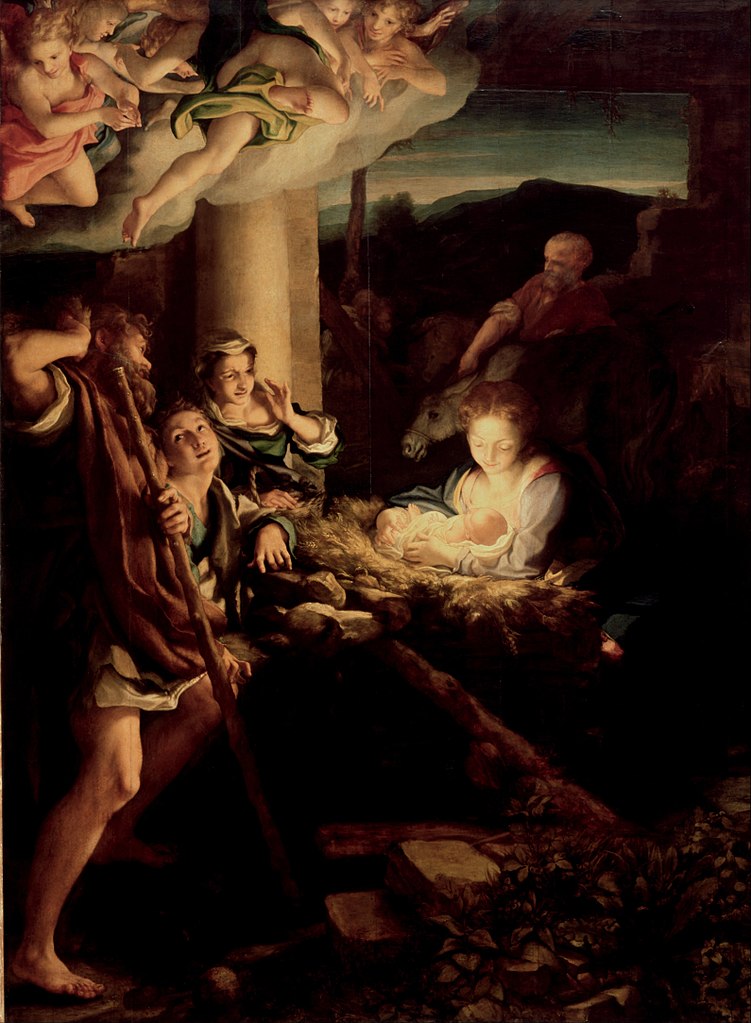Back to: Renaissance Art and the Christmas Story
Adoration of the Shepherds – Antonio da Correggio (1529-1530)

The scene pivots around the Child, surrounded by Mary’s arms, with a group of shepherds on the left, of which the bearded figure is portrayed in the same position of Jerome in the Madonna of St. Jerome (Correggio) traditional Nativity and St. Joseph. The upper left part features several angels reminiscent the positions in Correggio’s dome of the Cathedral of Parma, executed in the same years. On the right are nativity animals
Of note is the use of chiaroscuro. The technique is about working with high contrast between light and shadow and requires good knowledge of perspective, physical effects of light, brightness, and even the paints used
Renaissance painting was the first use of oil paints. Before oil paint, artists used other techniques, such as tempera, where the paint and pigments were mixed with egg white.
The problem with this technique was its opacity and its quick-drying characteristic, which made it impossible to paint several layers. Oil paint is a slow-drying paint in which the pigments are mixed in oil
Caravaggio’s art was marked by totally darkened backgrounds, with the objects and models illuminated by a single light source This combination created a high dramatic index in his works, and this extreme use of contrasts and chiaroscuro gave rise to a movement called Tenebrism. Tenebrism was born in the Renaissance, but grew stronger in the Baroque movement and extended into Romanticism.
The light appears simultaneously to bathe and to emerge from the Child, who is lying on a rough pallet, only to soften on the face of the Virgin, tenderly rapt in a maternal embrace. They are surrounded by the fluid gestures of the shepherds and of St Joseph, who is holding back the donkey, and by the kicking legs of the angels transported by the cloud that spreads hazily through the picture.
Domenico Ghirlandaio – Adoration of Shepherds (1485)

The shepherds depicted are witnesses to the birth of Jesus in Bethlehem, arriving soon after his actual birth. The painting highlights the humble beginnings of Jesus by emphasizing his placement in a manger surrounded by animals and common folk like the shepherds
This painting uses both atmospheric and linear perspective to create depth
The colors in the foreground of the painting are clear and bright while the colors in the background are dull and have a bluish tinge. The sky fades from a rich blue to an off-white when it reaches the mountaintop. This technique, known as atmospheric perspective, uses color and saturation to show depth similar to the way we perceive distance in the real world.
Domenico Ghirlandaio also utilized linear perspective, which creates the illusion that the background is receding into a vanishing point. The road curving along the left side of the painting leads the eye back to the vanishing point. The combination of atmospheric and linear perspective creates an incredibly realistic image that is similar to a mirror, allowing the viewer to look into and experience the nativity scene.
To influence his viewers Domenico Ghirlandaio utilized a theory known as “histories”. Historie is a narrative painting that instructs the viewer in a pleasurable way. Ghirlandaio includes many different figures to interest viewers such as the baby Jesus, the Virgin Mary, the shepherds, and the large group of people approaching the nativity. Throughout the Nativity and Adoration of the Shepherds, these people are shown in different poses and various movements.
In earlier artwork, different people were usually represented very similarly and without much variation. Giotto, for example, shapes or color contrasts rather than pictorial depth. The positions of people became incredibly dramatic with later artists. Ghirlandaio used new representations of motion within the altarpiece to express emotion and illustrate individuality among figures. The people represented in this painting vary in size, shape, and color, making them more realistic and adding validity to the narrative.
Ghirlandaio also incorporated a figure in communication with the viewer, which is a central aspect of histories. The shepherd to the right of the manger is pointing to the baby, showing that the Christ Child is the most important feature of the painting. In addition, the Virgin Mary and the other Shepherds are gazing directly at the baby Jesus, supporting that the focus is on him
The Adoration of the Shepherds also illustrates an interest in humanism that was prevalent throughout the Early Renaissance. The theory of humanism first gained popularity in the classical era but was revived by artists and intellectuals in the 15th century. Domenico Ghirlandaio incorporates aspects of classical history, such as the pillars with Corinthian capitals and the ancient sarcophagus, as a way to commemorate the achievements of humans throughout history. The people represented in this painting are very idealized forms, which references the search for perfection throughout the Classical Era.
Although the Virgin Mary looks quite realistic she is still very idealized because of her astonishing beauty and flawless appearance. This perfection enforces the biblical story that Mary remains pure and a virgin even after she gives birth to the Christ Child. The shepherds show some signs of aging like gray hair and a few wrinkles but overall their features also represent perfection.
